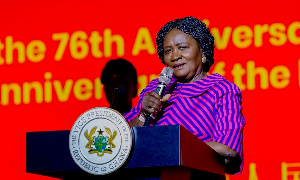There is a growing interest in the role of remittances in the Ghanaian economy. This interest has been heightened by the recent increase in the flow of remittances to Ghana. Remittances to Ghana amounted to over $4.5 billion in 2005, making it the largest foreign exchange earner. About 30 percent of this amount ($1.5 billion) came from individuals while the remaining amount came from religious and Non-Governmental Organizations (NGOs.) The value of migrants’ remittances increased from $201.9million in 1990 to 1.55 billion in 2005. Remittances have increased and have become more stable than Official Development Assistance (ODA), and Foreign Direct Investment (FDI). Further, remittances as a percentage of GDP rose from 3.2 percent in 1990 to 13.3 percent in 2003. Also, as a percentage of export, remittances rose from 22.5 percent to 40 percent within the same period. The issue of remittances has triggered a huge debate, largely because of the recent announcement by the Ghanaian government to tax part of migrants’ remittances to pay for the costs of providing physical and social infrastructures associated with housing development and other capital projects used by Ghanaian migrants. While the intent of the government is laudable, the economic feasibility of its intended policy is doubtful. The individuals always try to maximize their utility and will therefore find alternative ways to remit home without using the official channels if the government proceeds with its tax policy.
What the government needs to consider is how the Ghanaian migrants will respond to the government’s new policy. Knowledge from behavioral economics-- the application of insight from psychology to economics has enlightened many public policy makers in planning and carrying out workable public policies. Thus, any workable remittances policy must be guided by the behavior of migrants to the policy. The crucial questions the government needs to ask and to answer are: How will Ghanaian migrants react to taxes on remittances? How will the policy of taxing remittances affect the flow of remittances through the formal channel? What are the costs and benefits of imposing taxes on migrants’ remittances? What institutions will be responsible for monitoring the policy? How effective is the government in detecting and punishing those who send money through the informal channel? How do the tax collection agents distinguish between remittances for personal consumption and remittances for investments? And, who are the stakeholders in remittances issues with interest in influencing remittances flow, and their development impact? How can remittances be channeled into poverty alleviation and modernization? How does the government foster strategic alliances between banks and transfer companies, and between Ghanaian banks and their correspondents? How does the government leverage capital potential of remittances through transaction costs? And, how does the government leverage the impact of remittances through regulatory reforms and broker relationship to encourage investments by diasporeans?
A remittance policy that works must answer these policy questions, and devise measures to reduce transaction costs of remittances, before the policy is implemented. This article will not answer all these questions but to raise them for future policy discussions and debates. Readers seeking more elaborate discussion of the issues raised herein may consult my previous article: “A Case for Remittance Policy in Ghana,” Ghanaweb (2003).
Remittance policy that works must consider both the political, and enforcement will to carry out the new policy. Good public policy must have certain qualities. First, the policy must be clear in its objectives, concise in its enabling provisions, and consistent and persistent in its execution. Clarity in defining the objectives of a policy helps the policy maker decide what means to use to achieve desired goals. Second, the policy must be easy to interpret and to provide an enforcement mechanism, for example, an institution to enforce required action. Third, the policy must also be the product of a participatory process by considering the interests of stakeholders and engaging their collaboration. Fourth, the policy makers must also understand that a public policy to enhance the development impact of remittances involves multiple objectives, and multiple policy instruments. In another words, the design of such a policy involves potentially conflicting objectives and trade-offs. It is therefore important for the policy analysts to craft their policies in a way that seek to resolve or minimize all unintended policy conflicts in advance of implementation.
Further, a remittances policy that works must consider the diversity of migrants’ remittances. There are diverse forms of remittances: Intra-family transfers-- money sent by diasporeans to their relative at home; personal investment transfers--this is money sent by diasporeans for private investment at home; collective transfers-- money sent by hometown associations, usually directed towards community projects. Any effective remittances policy must understand the motivations for these transfers and how to maximize their economic potentials.
There are so many reasons why taxing remittances may be counterproductive, or unwise from an economic standpoint. First, remittances tax will redirect remittances from the formal channels to the informal channels; thus, worsening the balance of payments. Second, it can be argued that the recipients of remittances are in the best position to judge the best way to spend their money. Third, many Ghanaian migrants do not trust the government to use their hard-earned money for the national good: The pervasive and intractable nature of corruption in Ghana has resulted in the distrust of the government. The International Development Committee of the British House of Commons succinctly expressed this in its report when it writes: “Particularly given many migrants’ distrust of their home governments, clumsy governmental interference would be most unwelcome.”
Another argument against remittance tax is that taxing remittances will amount to double taxation on migrants’ income. The World Bank, in its Global Economic Prospects 2006 report, cautions governments against taxing remittances. The report states: “Remittances are hard-earned income that, in most cases, has already been taxed.” The Bank’s chief economist Bourguignon writes, “Remittances should not be taxed again, and governments should not try to count them as development aid.”
The argument that housing and other projects by Ghanaians abroad calls for providing physical and social infrastructures, the costs of which must be borne by the migrants as advanced by the Minister of Finance and Economic Planning misses the multiplier effects of the housing sector on the economy. Investments in housing create employment especially for the unskilled and semi-skilled unemployed, thus increasing their purchasing power and standard of living. In another words, there is a positive net benefit from housing and other projects undertaken by migrants. Further, it can be argued that the government still derives revenues from taxes imposed on imported materials for housing as well as property taxes from the completed houses.
The wisest strategy to get property owners to pay for the provision of physical and social infrastructures, I will argue, is to ensure that all residential lands in the big cities are serviced before sales. The prices of serviced-plots include the costs of infrastructural services. Apart from lessening land litigations the policy of servicing residential lands before sales to prospective developers will increase remittances flow into the country while getting migrants homeowners to pay for the costs of infrastructural services. The benefits from stimulating remittances flow through the official channels far outweigh the amount to be gained from taxing remittances.
The macro-economic impact of increased remittances flow through the official channel far outweighs the benefits to be derived from taxes on remittances. First, remittances ease foreign exchange constraints and improve the balance of payments. Second, migrants’ remittances allow imports of capital goods and inputs necessary for industrial development. Third, migrants’ remittances are potential source of savings and investment for capital formation and development. Fourth, remittances are net addition to our resources. Fifth, migrants’ remittances to their immediate family members improve their standard of living. And last, migrant remittances improve income distribution if the recipients are poor families. The World Bank report quoted earlier states, “Analysis of household surveys shows that remittances have been associated with significant declines in poverty (headcounts) in several low income countries, including Uganda (11 percent), Bangladesh (6 percent) and Ghana (5 percent).
Unlike development assistance transfers which mostly pay for the expensive lifestyles of NGO executives and lines the pockets of corrupt politicians, migrant remittances go directly to family members. Further, unlike foreign investment, remittance flows are more evenly distributed and far more stable. They tend to increase at difficult times-during an economic downturn when other private capital flows tend to decrease. It is therefore economically expedient, and politically wise for the government to concentrate its efforts on policies that will direct more remittances through the formal channel instead of a tax policy that will divert remittances flow away from the formal channel to the informal channel.
There are many policy instruments the government can use to improve development impact of remittances and enhance the flow of remittances through the formal channel. Which policy instruments the government selects depends on the desired goal it intends to achieve. First, if the government’s objective is to capture a portion of remittances for development purposes, then the policy instrument will be to impose taxes or levies on remittance transfers, or to explore voluntary check-off for charitable purposes. But as has been argued earlier, taxing remittances may be counterproductive. Second, if the government objective is to stimulate transfers through formal channels and to stimulate capital availability, then the policy instruments should focus on the sale of remittance bonds, opening of foreign currency accounts, premium interest rate accounts, promoting transfers through microfinance institutions, promoting financial literacy, and banking the unbanked. Foreign currency accounts and bonds have proven to be viable means of raising funds. This should be targeted at the diasporas middle-to-upper income members. For example, India and Pakistan maintain interest rates on foreign currency accounts that are higher than domestic or Euro-currency deposits.
In addition, if the objective is to stimulate investment of remittances then the government has to reach out to remittance receivers through Micro Finance Infrastructures. The government should also reach out to its migrants abroad through migrants’ service bureaus, and tax breaks on imported capital goods by migrants. Moreover, the government must reach out to Hometown Associations (HTAs). This can be done through the Matching Funding Programs, public-private ventures, and competitive bidding for development projects. The government may also influence consumption patterns by promoting the consumption of local goods and services, and devising programs that will enable migrants to spend on their immediate relatives. The purchase of health insurance by Ghanaian migrants for their relatives at home can be explored. Moreover, the Ghanaian government may stimulate its exports by facilitating and promoting the consumption of Ghanaian made products by its expatriates abroad.
To ensure future remittances flow to Ghana, the government must become an active participant in migration and remittances issues, instead of being a passive recipient. Countries like India, Mexico, and The Philippines with more successful remittances programs have well established institutions to train, support, and ensure the welfare of their expatriates abroad. The Ghanaian government needs to have a diaspora management agency or unit charged with the training, support, or welfare of its expatriates abroad. The Filipino government has an entire bureaucracy created for educating, training, and dealing with Filipino migrants. The Philippine Overseas Employment Administration helps find jobs in other countries for its citizens. The Filipino Technical Education and Skill development Agency offers free training in welding, driving of heavy trucks, and other skills to its citizens. Also, the Filipino Overseas Workers Welfare Administration stations diplomats around the world to look after the Philippines’ workers. Those who bring or send their money home pay no income taxes.
In India, the government has devised better incentives for its expatriates abroad to send and invest money in India’s growing economy. It has also eased regulations and controls, and eliminated the black-market premium on the rupee and has created convenient remittances services. The Indian and International banks have systematically shifted some remittances from the informal “hawala” channels to formal channels. Indians abroad have also responded to several attractive deposit schemes and bonds offered at home. The Ghanaian government can’t be a passive recipient of remittances. It must roll up its sleeves and become an active participant in migration and remittances issues. It does not have to do this alone since there are many actors in the game.
The Ministry of Finance should involve all the stakeholders in migrants’ remittances in the formulation and deliberations of it remittances policy if it intends to craft a workable remittance policy. Often, the authorities of remittance-receiving countries naively assume that policy initiatives must come from them without the participation of the other stakeholders. However, there are many stakeholders with interests in shaping remittances flows, their uses, and their development impact. These groups consists of migrants associations, the migrants themselves, other NGOs both at home and abroad, multilateral agencies, and some governments’ agencies from the western world. Governments’ organizations like NORAD (Norway), DFID (United Kingdom), SIDA (Sweden) and many others have expressed interest in assisting and in carrying out remittances policy. The Ministry of Finance should therefore make the necessary effort to involve these stakeholders in the formulations and deliberation of remittances policy.
Notwithstanding the multiple policy objectives and instruments available to the government to enhance the development impact of remittances, the government must exercise caution in selecting its policy objectives and instruments. This is because the design of remittances policy involves potentially conflicting objectives. For example, a government attempt to capture a share of remittances for development purposes might conflict with its goal or objective to stimulate remittance transfers through formal channels. Because an attempt to capture a portion of remittances for development purposes entails taxing migrants’ remittances, imposing duties, or levies on remittances transfer. All of this will discourage migrant workers from remitting home using the formal channels. Conversely, tax incentives may attract remittance inflows, but may create opportunities for tax evasion. Also Matching-Funding programs for migrant associations may channel collective remittances to development project, but in so doing they may divert funds from other local funding priorities. It is therefore important for the policy analysts to do a thorough “compatibility matrix” analysis on all the policy objectives discussed.
In conclusion, the Ghanaian government must understand that remittances can’t be a panacea to our structural economic problems. Remittances don’t automatically contribute to national development. To carry out effective and efficient public policies to channel remittances into productive projects, the government has to look at what motivate Ghanaians to send money home particularly beyond individual family remittances, and craft its policies to take advantage of it. Studies show that people send money home for many reasons beyond individual remittances and that these reasons provide a basis for acting collectively instead of acting individually. Two key factors that stimulate collective remittances are: The ability to mobilize through networks and associated social capital, and creation of a sense of solidarity and community identity. The government must therefore use its embassies abroad to foster a sense of solidarity and community identity among Ghanaians abroad. The government should also actively solicit Diaspora participation and contribution through workable policies and programs. This may involve creating regulatory support economic opportunities, and giving the diaspora community access to position of authority and respect.















